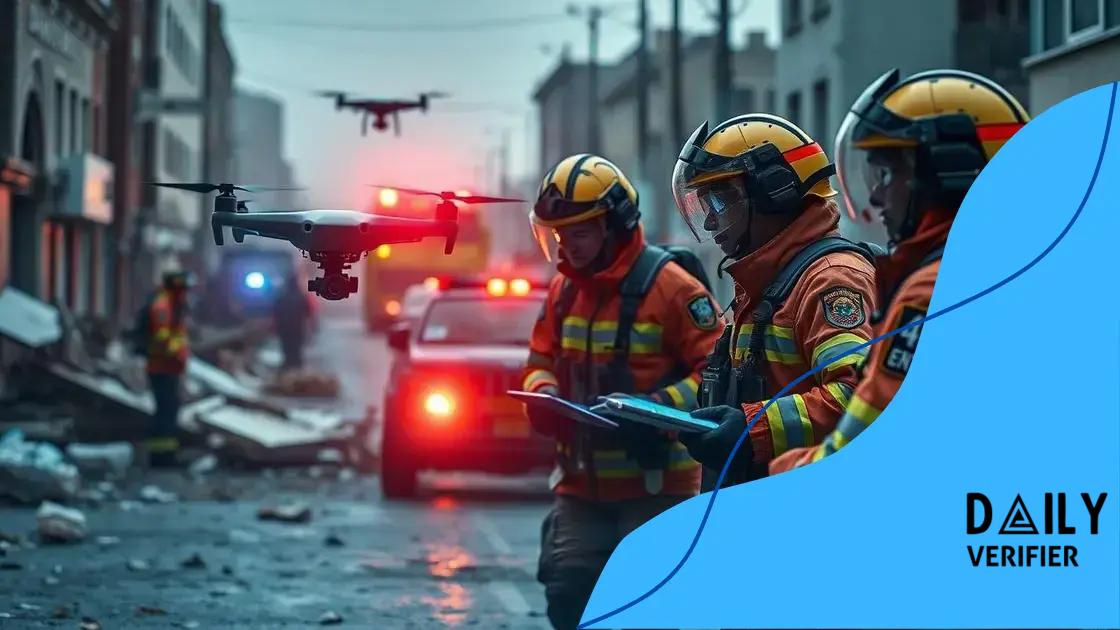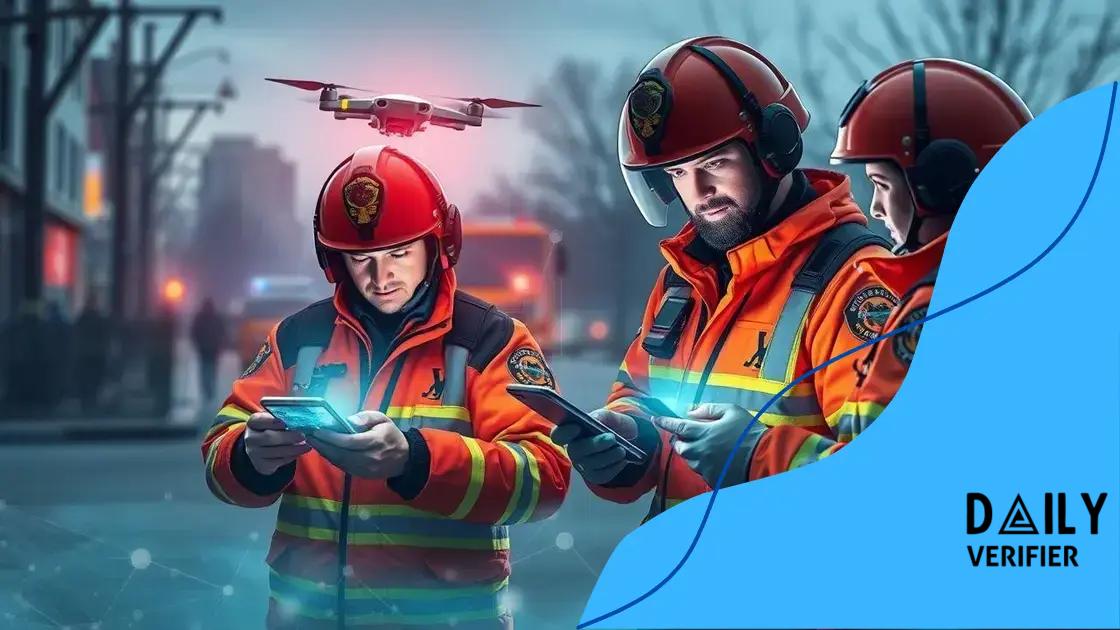Emergency aid sped up: how technology is changing responses

Emergency aid sped up through technology enhances response efficiency by utilizing drones for delivery, real-time data for decision-making, and fostering collaboration among organizations to address the challenges of disaster situations effectively.
Emergency aid sped up is reshaping how we respond to crises, making help faster and more efficient. Have you ever wondered how technology is changing disaster relief?
The role of technology in emergency aid
Technology plays a vital role in enhancing the effectiveness of emergency aid. When disasters strike, timely and accurate information can make all the difference. With the integration of various technologies, rescue efforts have become faster and more efficient.
How Technology Improves Communication
During emergencies, communication is key. Technologies like mobile apps and satellite phones enable quick information sharing among rescue teams and victims. This allows for better coordination and quicker response times.
- Real-time updates keep everyone informed.
- Mobile apps connect victims with resources.
- Satellite communications ensure connectivity in remote areas.
Advanced mapping and GPS technologies also play a crucial role. They help responders navigate to the affected areas more accurately. This minimizes delays and ensures that aid reaches those in need promptly.
Innovative Tools in Emergency Aid
Another significant advancement is the use of drones for delivering supplies. Drones can quickly transport medical aid, food, and water to locations that are hard to access. This not only saves time but also helps in saving lives during critical situations.
- Drones conduct aerial surveys to assess damage.
- They provide a bird’s-eye view to strategize response efforts.
- Delivery drones can reduce the time for emergency supplies.
In addition, the use of social media platforms for reporting disasters has transformed how people receive information. Widespread sharing of data can lead to faster mobilization of resources, as communities can work together seamlessly.
Overall, the role of technology in emergency aid cannot be overstated. It enhances response capabilities and increases the chances of saving lives during crises. As technology continues to evolve, we can expect even more innovative solutions to emerge in the field of disaster relief.
How drones are revolutionizing disaster response
Drones are transforming the landscape of disaster response, providing solutions that were previously unimaginable. With their ability to access areas that are unsafe for humans, drones are playing a crucial role in delivering aid swiftly and efficiently.
Versatility in Delivery
One of the most significant advantages of drones is their versatility. They can carry various payloads, making them ideal for transporting essential supplies such as medical kits, food, and water. When traditional transportation methods are impeded, drones ensure that help reaches those in need.
- Drones can deliver supplies to remote locations.
- They can transport medical aid in emergencies.
- Quick deployments save valuable time during crises.
Beyond delivery, drones provide valuable real-time data. They can survey large areas quickly, capturing images and videos that help responders assess the situation on the ground. This information is vital for planning effective responses.
Enhancing Search and Rescue Operations
Drones also enhance search and rescue operations. Equipped with thermal imaging cameras, they can locate people trapped in debris or displaced in wide areas. This technology significantly increases the chances of successful rescues, especially in chaotic situations.
- Thermal imaging helps identify heat signatures.
- Drones can cover vast areas faster than ground teams.
- They reduce the risks to human first responders.
The integration of drones into disaster response teams exemplifies how technology can improve outcomes. By working alongside traditional methods, drones provide innovative solutions that enhance overall efficiency during emergencies.
Real-time data: improving decision-making in crises

Real-time data is a game changer in how we respond to crises. When emergencies occur, having access to current information can significantly enhance decision-making. This capability allows responders to act quickly and effectively, ultimately saving lives.
The Importance of Accurate Information
In any disaster, knowing what is happening on the ground is crucial. Data collected through various sources, such as social media and sensors, provides insights that can guide decision-makers. Quick access to this information can lead to more informed choices during critical moments.
- Real-time data helps identify the hardest-hit areas.
- It tracks the movement of people and resources.
- Fast updates allow for swift adjustments to rescue plans.
As the situation evolves, having a reliable stream of data means that teams can adapt their strategies on the fly. This agility is essential for effective crisis management and ensures that help is delivered where it is needed most.
Technologies Enabling Real-Time Data
Various technologies support the gathering of real-time data. Drones, for example, can provide aerial imagery that reveals the extent of damage from above. Additionally, mobile applications can be used by citizens to report incidents, helping authorities gain a clearer picture of the emergency.
- Drones capture real-time aerial footage.
- Mobile apps allow citizens to report emergencies.
- Sensors monitor environmental conditions immediately.
The integration of these technologies ensures that emergency responders have the most accurate and timely data to inform their actions. With real-time information flowing in, the chances of successful outcomes in crisis situations increase dramatically, showcasing the power of data in improving overall response durability.
Success stories: effective emergency aid implementations
Success stories in emergency aid illustrate how innovative solutions can make a real difference during crises. These examples show the power of collaboration and technology in providing timely assistance to those in need.
Case Study: The Response to Natural Disasters
One remarkable success was seen during a major hurricane that struck the coast. Emergency responders utilized advanced technology, including drones and real-time data apps, to assess damage quickly and deliver supplies efficiently. By coordinating with local volunteers, they ensured that resources reached affected communities without delay.
- Immediate aerial surveys helped identify the hardest-hit areas.
- Food and water were distributed using drones to remote locations.
- Collaboration with local groups sped up the recovery process.
Another impactful case occurred during an earthquake, where organizations employed a mobile app for resource tracking. This tool allowed responders to keep tabs on available supplies and quickly allocate them based on demand. They could also gather feedback from the community, making sure help was effectively targeted.
Lessons from International Aid Efforts
Internationally, efforts in places like Nepal during earthquake recovery are also noteworthy. Aid workers incorporated technology to reach vulnerable populations. They set up communication channels that allowed for two-way messaging, enabling victims to report their needs directly.
- Use of SMS services helped track ongoing needs in real-time.
- Mapping software identified locations requiring urgent assistance.
- Crowdsourced information improved situational awareness for teams.
These success stories emphasize the necessity of adaptation and innovation in emergency aid. By sharing experiences and leveraging technology, responders can create frameworks that lead to effective outcomes even in the face of severe challenges.
Challenges and future directions for emergency aid technology
The landscape of emergency aid technology is constantly evolving, yet it faces several challenges that must be addressed. As disasters become more frequent and severe due to climate change, relying on innovative solutions is crucial for effectively aiding those in need.
Key Challenges in Implementing Technology
One major challenge is the integration of new technologies into existing systems. Many organizations struggle to adopt innovative tools while maintaining effective communication and collaboration. Issues such as training personnel and ensuring compatibility with older systems impede the adoption of technology.
- Limited resources can hinder the purchasing of advanced tools.
- Data security concerns can prevent organizations from utilizing cloud-based solutions.
- Resistance to change among staff can slow down implementation.
Another significant challenge is ensuring equitable access to technology, particularly in underserved areas. While advanced tools like drones and mobile apps can significantly improve response times, access to these resources can vary based on location and funding.
Future Directions for Emergency Aid Technology
Looking ahead, there are promising developments that could enhance emergency aid efforts. Increased collaboration between organizations and tech companies can lead to customized solutions that cater to specific needs. Enhanced training programs will ensure that responders are well-equipped to use the latest technology effectively.
- Partnerships can foster innovation tailored to local challenges.
- Investing in education will prepare future responders for tech integration.
- Open-source platforms can promote accessibility and collaboration among organizations.
Additionally, leveraging artificial intelligence can help analyze data more efficiently and improve resource allocation during crises. By addressing current challenges and exploring future directions, the field of emergency aid technology can evolve to meet the demands of a changing world.
In conclusion, the role of technology in emergency aid is crucial for effective disaster response. By utilizing innovative solutions, we can enhance our ability to deliver timely assistance and save lives. However, challenges such as integration and access must be addressed to fully realize the benefits of these technologies. Looking forward, collaboration between responders and tech companies, along with advancements in training and artificial intelligence, will pave the way for more efficient emergency aid responses. Together, we can create a more prepared and resilient future in the face of crises.
FAQ – Frequently Asked Questions about Emergency Aid Technology
What is the role of technology in emergency aid?
Technology enhances the efficiency and effectiveness of responding to disasters by enabling quicker communication, real-time data access, and innovative delivery methods.
What challenges do organizations face in implementing emergency aid technology?
Organizations often struggle with integration, resource limitations, and ensuring equitable access to new technologies, which can slow down response efforts.
How do drones benefit disaster response?
Drones can provide aerial surveys, deliver supplies to hard-to-reach areas, and enhance search and rescue operations, significantly improving aid delivery.
What are the future trends in emergency aid technology?
Future trends include increased collaboration between tech and aid organizations, enhanced training programs, and greater use of artificial intelligence for data analysis and resource management.






